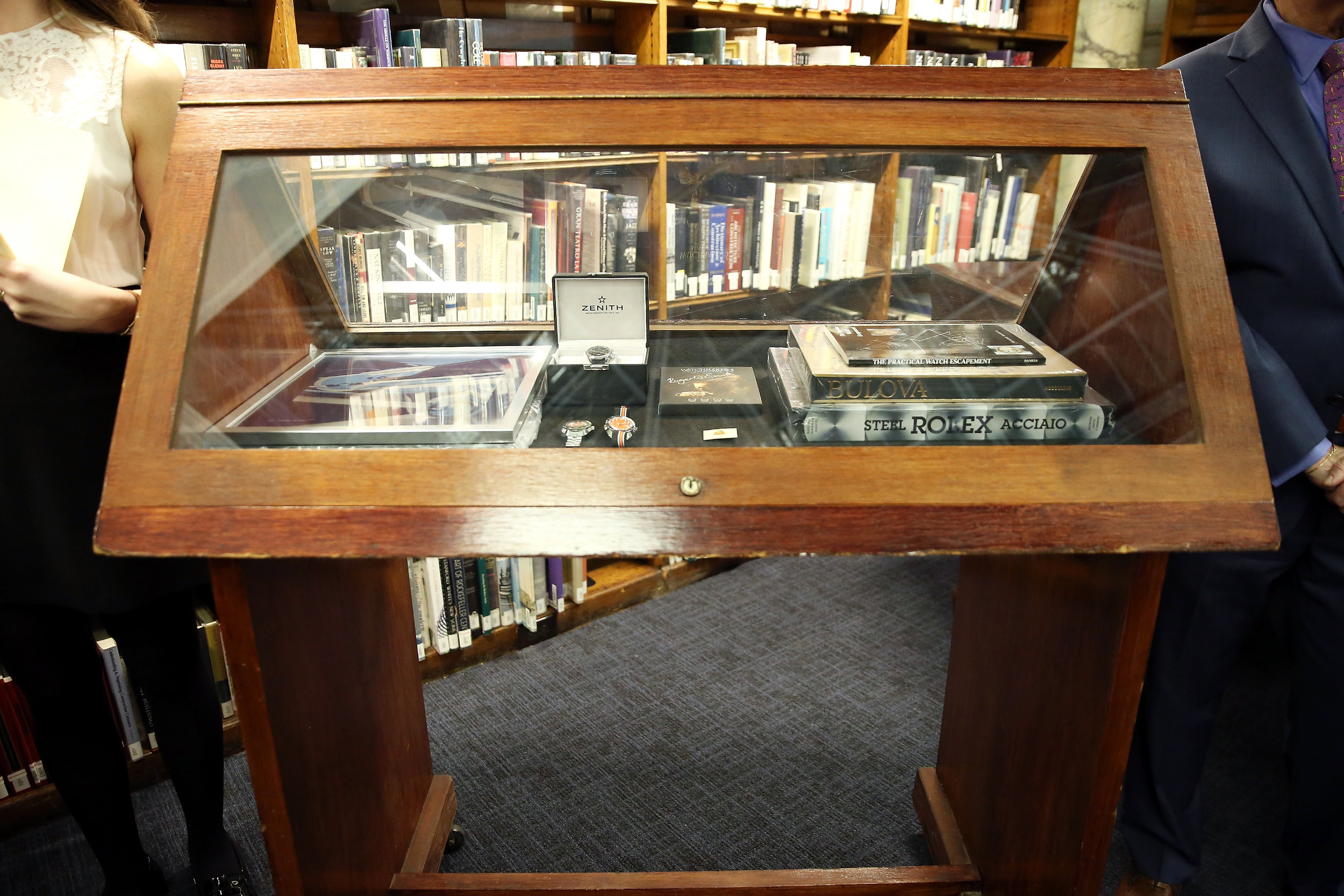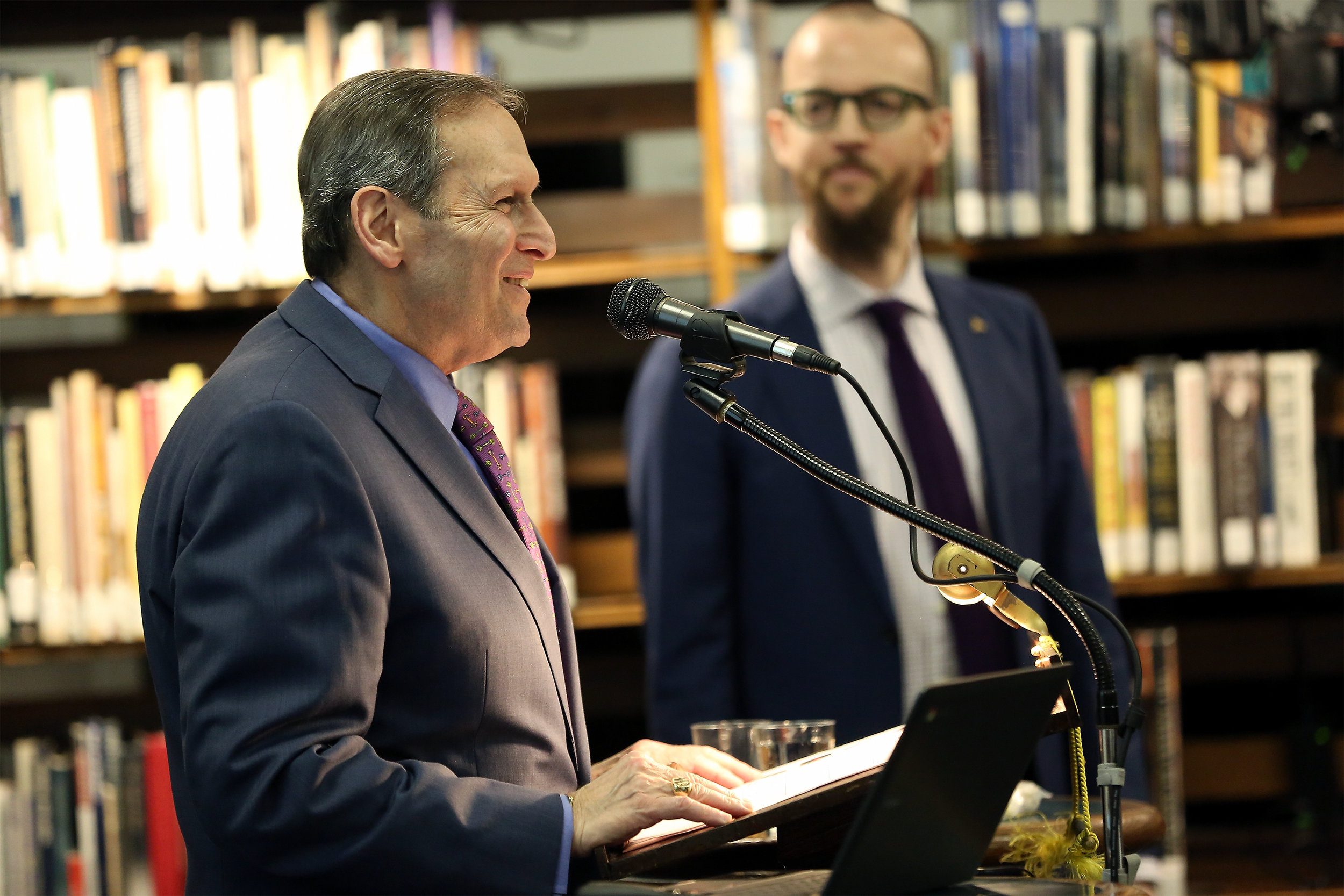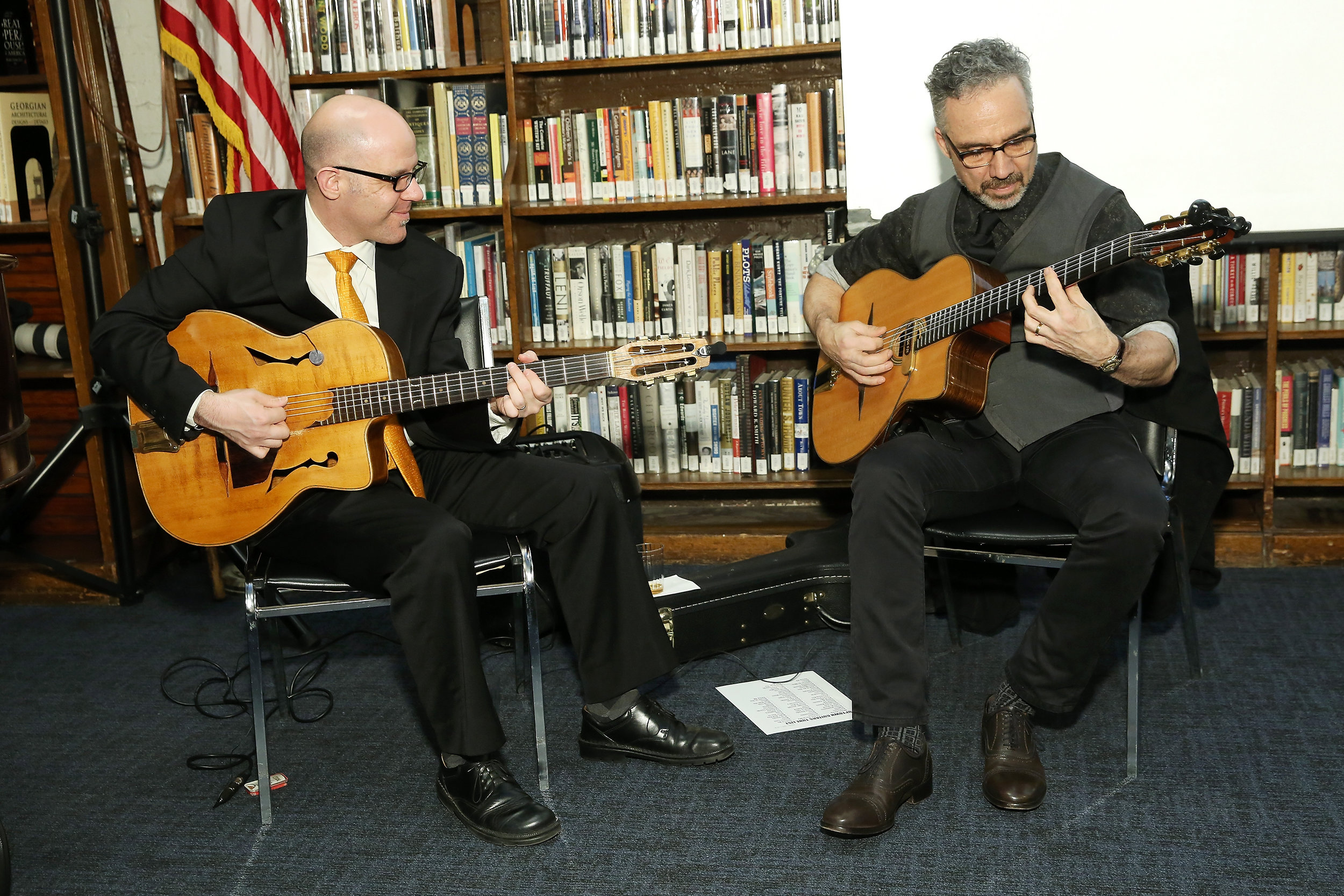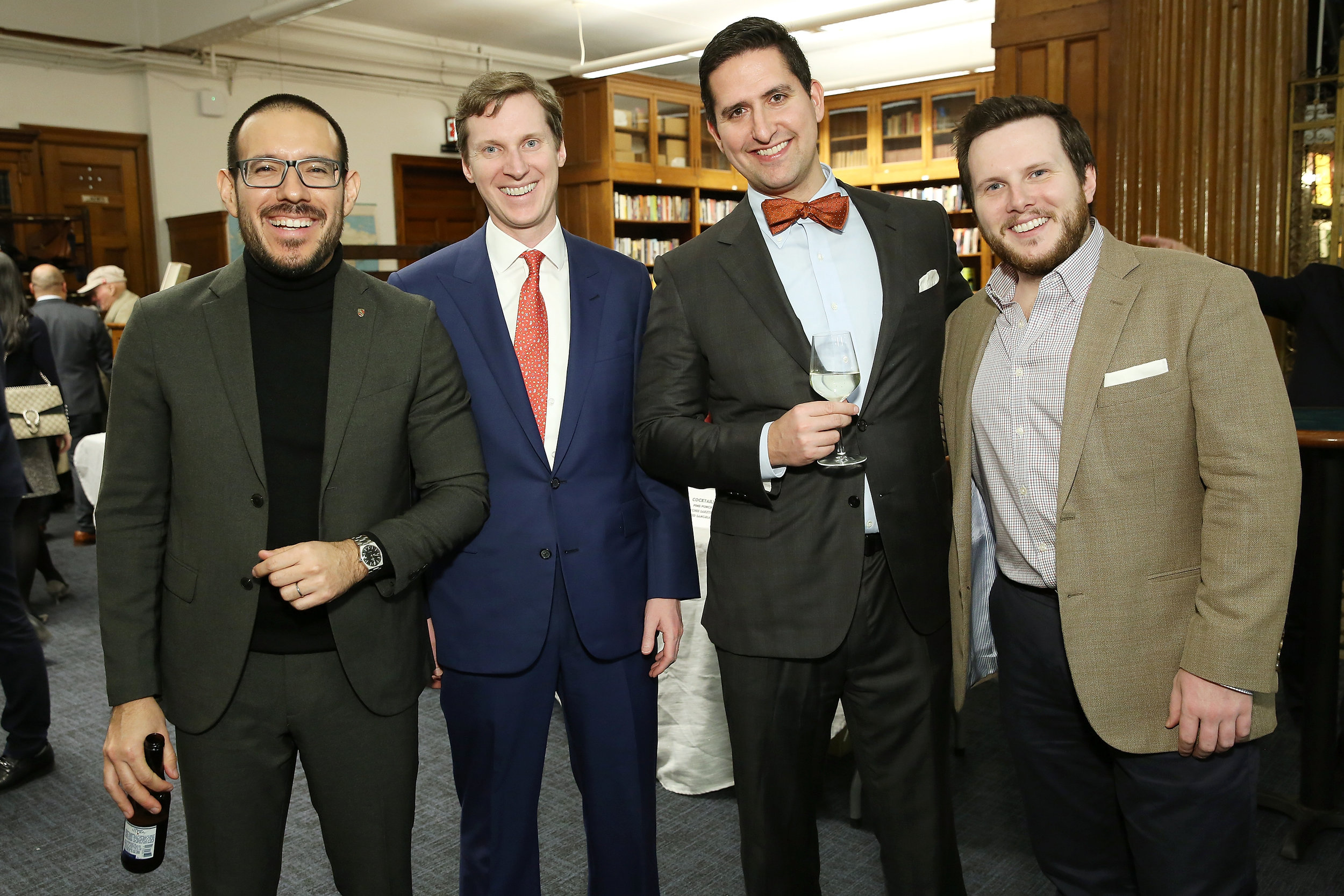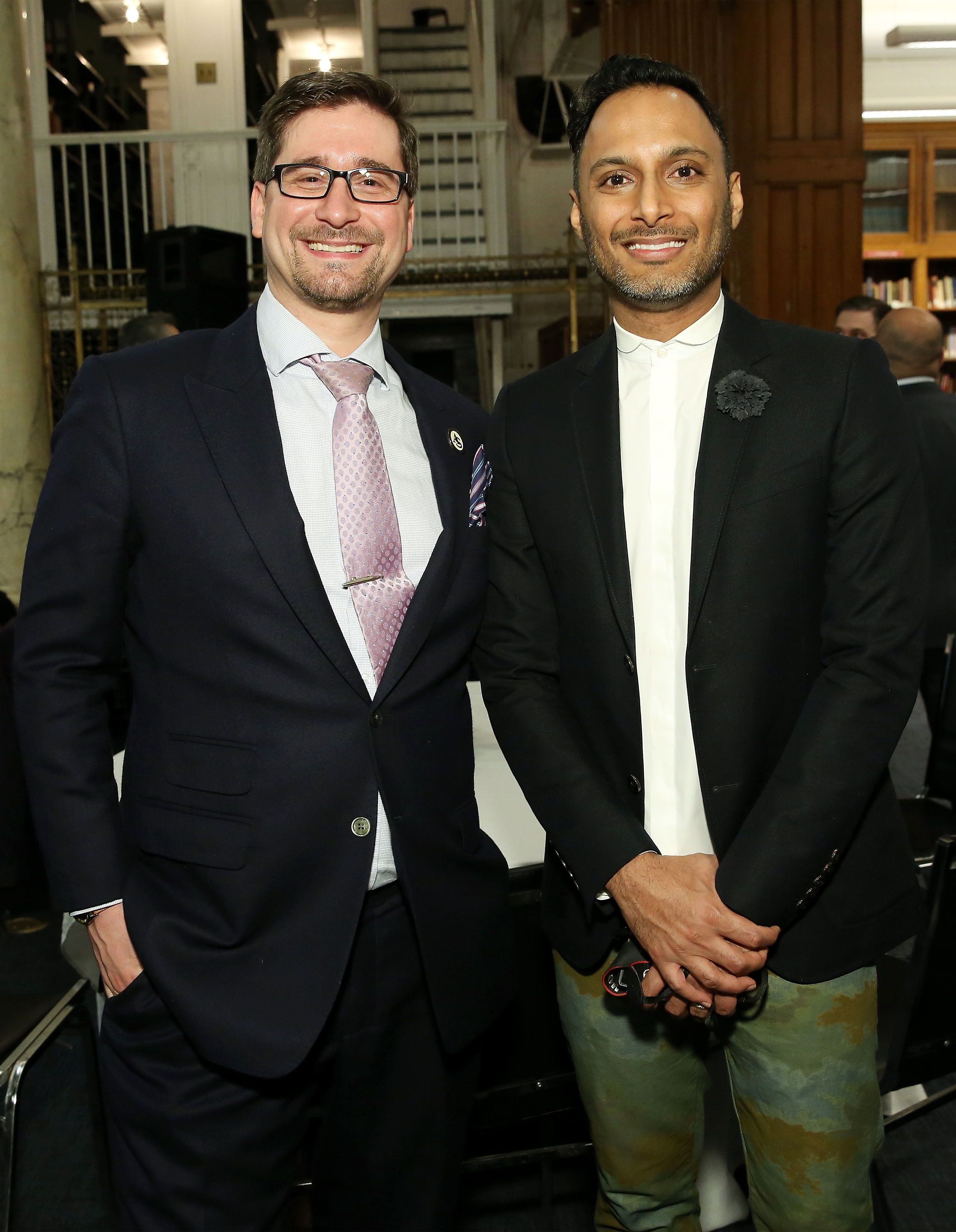
The Horologist’s Loupe
The Horological Society of New York's newsletter (and today blog!) began publishing in 1936, and is one of the oldest continuously running horological publications in the world.
Meeting Recap: Mechanical Jewels: The Art of the Watch 1500 – 1800
Video recordings of lectures are available to members immediately (using your membership password), and the general public with a 2 month delay.
Jonathan Snellenburg, Director of Watch and Clock Sales for Bonhams Auctioneers, New York
September 13, 2018
The functionality of watches has changed over the centuries but one thing that has remained constant is their unwavering beauty. Such was the topic at the September 13, 2018, meeting of the Horological Society of New York, where Jonathan Snellenburg discussed the evolution of timepieces and how watches evolved to look like what we recognize today.
Snellenburg, Director of Watch and Clock Sales for Bonhams Auctioneers, set the stage in the 1500s, where the watch’s distant relatives were not worn on the wrist nor carried but rather appeared as miniature table clocks. These predecessors were small and thick, partly due to limitations of the placement of vertical crown wheels.
Up next in the watch’s evolution was to make timepieces portable. In the 1600s these ticking machines took the form of pendants, often oval and streamlined with covers to protect the hand and dial. Covers also provided a canvas for decoration where watches came to depict paintings, thus becoming vessels for symbols and symbolism.
An era of color sprung in the 1700s, where the rise of watches coincided with enamel painting. Watches became a medium to carry a piece of art, especially with enamel being all the rage. Coinciding with more detailed decorations was the gradual change from pendant jewelry to more precise timekeepers with the introduction of the balance spring in the late 1700s. Watches had graduated from expensive novelties to useful timekeepers with the new harmonic oscillator.
The lecture concluded with the beginning of the 18th century, where watches migrated from enamel designs to highly decorated pieces of metalwork. Watches became part of the costumes of the century, worn by elegant ladies and given as diplomatic gifts. Then, the appearance of watches radically changed with the development of horizontal escapements, which lead to the thin watch styles we see today.
This would later set the stage for 19th century complications which brings us up to modern time – where watches are now inexpensive enough for anyone to own. Whether the cost is $24 or $240,000, beauty is in the eye of the beholder and far more goes into the value of a timepiece beyond its price tag.
HSNY thanks Jonathan Snellenburg for his fascinating lecture!














Photography by Atom Moore
Upcoming Lecture: Mechanical Jewels: The Art of the Watch 1500 – 1800, by Jonathan Snellenburg
Join HSNY on Thursday, September 13, 2018 for a lecture on Mechanical Jewels: The Art of the Watch 1500 – 1800, by Jonathan Snellenburg, Director of Watch and Clock Sales for Bonhams Auctioneers, New York.
Jonathan Snellenburg
Early watches look deceptively like their modern descendants. They are familiar enough to assume the first watches were made to "keep time" as watches do today. Not so. In fact, these early watches were actually indifferent timekeepers, more suited to symbolize time than reliably measure it. Although technical advances over the next 200 years improved their performance, it was not until the end of the 18th century that ordinary watches became truly reliable timekeepers.
The earliest watches were probably carried not so much because civilization required portable timekeepers, but rather because of the Renaissance fashion for pendant jewels that served as both display of wealth and talisman. The early 20th century horologist, G. H. Baillie, referred to this developmental period as the "Age of Decoration." Watches were often fashioned into diverse forms and decorated with scenes from Classical literature. Both the form and decoration of these watches were intended convey a message how to make the best use of time.
Using sources from the fine and decorative arts, this lecture considers the imagery of these early jewel-like watches and illustrates how their appearance reflected society’s evolving attitude toward time and timekeeping. Only when the watch was transformed from metaphor into measuring device in the late 18th century did the “pocket watch” take its familiar modern form.
Read the full story here!
In The News: HSNY Trustee John Reardon’s Thoughts on Patek Philippe, Fakes & Hip Hop
John Reardon, Christie's International Head of Watches and fellow HSNY Trustee was recently featured on CNBC for his Patek Philippe expertise. Check out the article (and video!) below for Reardon’s take on fakes. Tune in closely as Reardon delivers catchy hip hop lines on some of the finest watches ever produced. #toomuchsauce
HSNY Limited-Edition Ties Now Available Online
Commemorate HSNY’s 152nd anniversary with limited-edition ties, available in blue and teal!
Custom crafted by Vineyard Vines, these ties are made from 100% imported silk and feature an escape wheel and pallet fork design throughout.
HSNY ties retail for $85 for HSNY members and $100 for non-members. Free domestic shipping is available. All proceeds go towards funding HSNY’s mission to advance the art and science of horology through education.
This marks the first time in HSNY history where a product has been created to commemorate an anniversary. The ties were manufactured in very limited quantities and are only available while stock lasts. These accessories make for an elegant, unique gift and are a must-have for any horological aficionado.
Meet The Board: Ed Hydeman, Executive Director
We’re launching a new series titled Meet The Board, where every month, we’ll profile one of HSNY’s Board members in our newsletter.
Whether you’ve been a part of HSNY for decades or are a new member, we wanted to reintroduce ourselves and share some of our favorite anecdotes, tips and fun facts.
Kicking off the series is none other than our Executive Director, Ed Hydeman. Be sure to say hello to Ed at our next meeting, scheduled for September 13!
HSNY Lectures now available on YouTube!
Missed a lecture meeting? Want a refresh? HSNY monthly lectures are now available on our YouTube channel!
America’s oldest watchmaking guild is bridging the gap between time and technology with a new YouTube channel allowing the public free access to its educational lectures.
To provide an all-encompassing understanding of horology, lecture topics throughout the century have run the gamut from historical, cultural, technical, business and more.
In addition to priority access to meetings and events, HSNY members benefit from immediate access to lectures, which often serve as a valuable source for members abroad. After two months, complete footage will now become available to the public free of charge and live on HSNY’s YouTube channel.
“Our monthly lectures are one of the oldest traditions at the Horological Society of New York,” said HSNY President Nicholas Manousos. “We never want to lose sight of our mission to educate, and today’s technology has allowed us to make good on that promise. Between the introduction of a YouTube channel, our Traveling Education program and our social media presence, we are more connected than ever and able to be a leading source of horological education for people worldwide."
Don't forget to subscribe!
Member Highlight: How One HSNY Member Is Preserving History On 44th Street, One Clock at a Time
For many Horological Society of New York members, it’s fulfilling enough to attend monthly lectures and celebrate the Society at the annual gala. For Justin Shellenberger, becoming part of America’s oldest watchmaking guild led to great advancements in his scholastic and professional career.
A graduate of Rolex’s prestigious Lititz Watch Technicum in Pennsylvania, Shellenberger discovered his love of horology when he picked up a book on the subject. His background in physics helped him to understand many of the finer details of the theory and he soon enrolled in the school to build the experience and skills necessary to be successful. He first learned about HSNY in 2016 when the school posted application details of HSNY’s first Henry B. Fried Scholarship, created to assist watchmaking students succeed in their studies and help cover equipment costs. After careful review by HSNY’s board, Shellenberger became the first student to receive the scholarship in 2017. Little did he know HSNY would present him with an opportunity to repair a one-of-a-kind clock.
An Opportune Time
As HSNY President Nicholas Manousos was walking through the General Society building – a landmark beauty built in 1890 which is home to HSNY’s office and classroom – he noticed a beautiful Seth Thomas regulator clock in the Executive Office on the mezzanine was not running. After investigation, Manousos discovered the clock dating back to the 1800s had been broken for some time. Naturally, HSNY decided to step in and offer to repair the antique.
“Justin immediately came to mind as the man for the job,” said Manousos. “He’s very skilled in clock repair and HSNY is always looking for ways to help our community and involve our members.”
In addition to repairing the clock which was revealed to have a severely damaged calendar, Shellenberger was tasked with creating new parts, including a calendar hand which he redesigned with the General Society’s arm and hammer logo.
“I came up with the idea to customize the hand as an ode to the building in which the clock is housed,” said Shellenberger. “Returning the Seth Thomas clock to working conditions while trying to not represent the repair as falsely original was important given its age and history. I’m glad the General Society met my suggestion to add a new memento with such enthusiasm.”
"We are so grateful for the magnificent restoration of our precious 19th century-old Executive Office Clock," said Victoria A. Dengel, Executive Director of The General Society. "Justin gave a treasured work of craftsmanship new life through the dedicated work of his hands. His masterful work in restoring the Society's precious clock will be recalled as a very special moment in the history of the General Society."
News spreads fast and since then, Shellenberger has repaired an English tall case clock also on 44th street at the legendary Algonquin Hotel. (The clock had been standing in their lobby since the early 1900s when it was taken as payment for an unpaid bill.)
“Joining HSNY has proven to be an incredibly beneficial relationship so far,” said Shellenberger. “Helping me fund my watchmaking studies is something I’ll never forget but having the opportunity to put my practice to work and preserve history is the icing on the cake.”
Check out Justin Shellenberger's website - https://tidsmed.com.




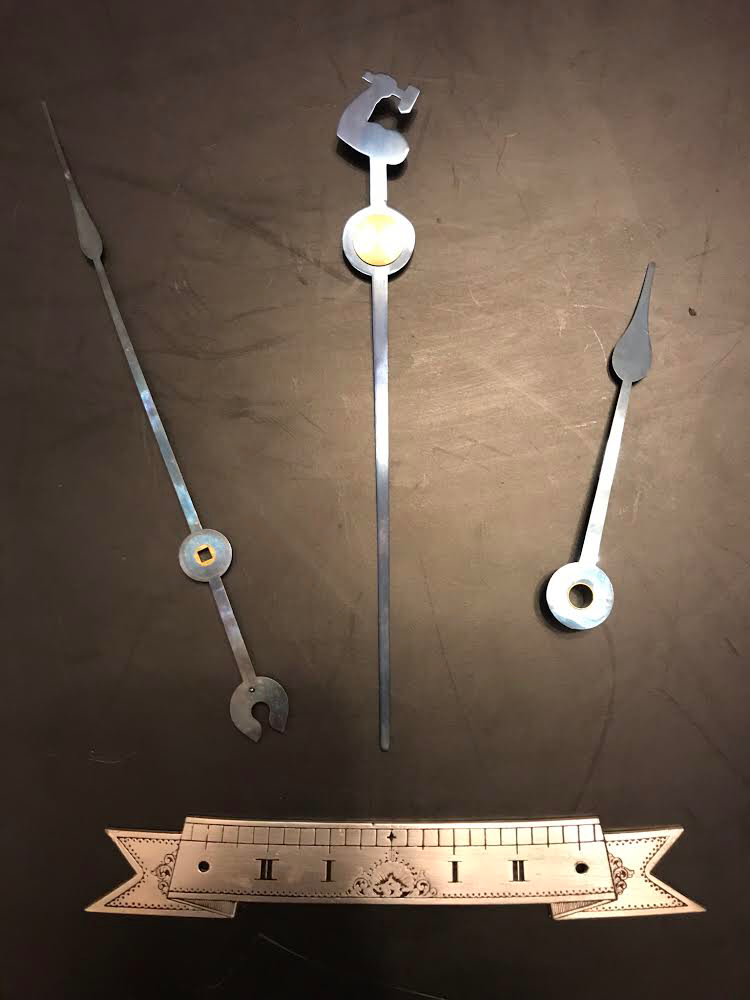


NAWCC to host Cars, Clock, and Watches Symposium
September 20-22, 2018
The Henry Ford Museum of American Innovation
Dearborn, MI
Are you a fan of automobiles and timepieces? If so, the Cars, Clocks, and Watches symposium on September 20-22, 2018 in Dearborn, Michigan is the event for you!
Join the National Association of Watch and Clock Collectors (NAWCC) as it celebrates its 75th anniversary at the Henry Ford Museum of American Innovation.
Discover the lesser know history about the business magnate whose mechanical curiosity was fueled at a young age by tinkering on clocks and watches. Ford’s fascination of horology would help mold his pioneering advances in automotive mass-production and usher in the link between horology and automobiles we still see today.
Registration for the Cars, Clocks, and Watches symposium hosted by the NAWCC – the largest horological organization in the world – can be accessed here. For more information, visit www.carsclocksandwatches.com.
The Henry Ford Museum of American Innovation
HSNY's Traveling Education Heads To Singapore
The Horological Society of New York's Traveling Education program is heading to Singapore! For the first time in 152 years, America’s oldest watchmaking guild will visit Asia and host classes in the heart of Orchard Road at Malmaison by The Hour Glass.
One of the world’s leading specialist watch retailers, The Hour Glass will open the doors of its luxurious thematic salon for a 2-day educational program taught by Vincent Robert, HSNY's Director of Traveling Education, with the assistance of a certified watchmaker from The Hour Glass.
On September 8 & 9, eight watch enthusiasts will have the unique opportunity to assume the role of watchmaker and discover what makes a timepiece tick. Students will be guided through an intimate, hands-on experience examining the inner workings of an ETA 6497 movement and go beyond scratching the surface of horological education. The four-hour course will cover material from HSNY's Horology 101 – 103 classes, to include exercises on movement mechanics, gear training, and winding and setting.
Courses will be offered on Saturday, September 8 (9AM – 1PM & 2:30PM – 6:30PM) and Sunday, September 9 (9AM – 1PM & 2:30PM – 6:30PM). Admission is $500 USD and includes access to watchmaking tools and a mechanical watch movement for the duration of the class. No previous experience is required. PURCHASE TICKETS HERE.
Anna Rolls Appointed Curator of the Worshipful Company of Clockmakers' Collection and Archive
Established in 1631, London's Worshipful Company of Clockmakers is the oldest surviving horological institution in the world. The Company's incredible collection is on display at the Science Museum in South Kensington, London, open free to the public daily. After more than thirty years of service, Past Master Sir George White decided not to seek re-election as Keeper of the Collection and Anna Rolls was appointed as Curator.
Anna Rolls is a conservation professional with over eight years of experience working within the museum sector. Rolls previous position was at the Royal Museums Greenwich, where she worked as the Objects Conservator for Scientific Instruments. Rolls recently carried out research on the Greenwich Time Ball as part of its ongoing repair, and delivered a joint lecture on the subject at the Royal Observatory. Rolls graduated from the University of Sussex in 2008 with a MA in Conservation Studies. Rolls has a Postgraduate Diploma in Conservation of Fine Metalwork from West Dean College and is studying for the Diploma in Repair, Restoration and Conservation of Watches through the British Horological Institute's Distance Learning Course.
Past Master Sir George White said that he is "delighted to welcome Anna into the new role of Curator and looking forward to passing on so much of the history of the Clockmakers' Company that lies behind the items in the Collection."
The Horological Society of New York congratulates our friends across the Atlantic on their continued success in advancing the art and science of horology, and wishes all the best to Anna Rolls with her new position.
HSNY Summer 2018 Survey - NOW LIVE
Our summer 2018 survey is now live! If you haven’t already, please take a moment to answer a few questions in order to help us with future planning. Have additional comments or ideas? Drop us a line here.
HSNY Welcomes New Team Members
Vice President John Teifert (left) and HSNY Instructor Vadim Finkel (right)
HSNY is proud to announce the appointment of new Board Members and Trustees. The 152-year-old society continues to grow, electing John Teifert as Vice President. John Davis and John Reardon were also elected as Trustees.
Sam Matlick joins HSNY as Director of Strategic Planning. Melody Benloss and Carolina Navarro join the Board as Librarian and Director of Public Relations & Marketing, respectively. For press inquiries, please contact carolina@hs-ny.org.
HSNY Holds Its First International Class in Toronto, Canada
HSNY held its first international classes in Toronto, Canada, on July 7th and 8th,, 2018. The sold out classes were hosted at Charles Pachter's Moose Factory Gallery by Moe Jaber.
"Over the past two years, HSNY's traveling education team has done an incredible job in taking watchmaking on the road, visiting fifteen cities across the US,” says HSNY President Nicholas Manousos. “Now, HSNY is expanding its reach with its first international class in Toronto, Canada. We want to share the joy of watchmaking with the world, and we hope to see you soon at a horological education class."
Through HSNY's Horological Education, students discover what actually makes a watch tick with hands-on classes taught by HSNY's staff of professional watchmakers. During the half-day workshop, students work on a mechanical watch movement, studying the gear train, winding and setting mechanisms, and escapement.
Follow HSNY on social media for the latest traveling education announcements. Want us to visit your city next? Sound off on social!









John Harrison Statue Appeal
Photo Credit: The Better Barrow Community Project
The Better Barrow Community Project, a registered charity dedicated to advancing the education of the public in the life, work and achievements of John Harrison, is currently raising funds towards commissioning a statue to honor Harrison, the inventor of the world’s first reliable and accurate marine chronometer.
According to the charity’s website, the statue will be the first of its kind celebrating the achievements of Harrison. The life-sized bronze statue will be erected in Barrow-upon-Humber where Harrison lived at the time he developed the revolutionary solution that increased the safety of long-distance sea travel. The commission of the internationally-funded project will be carried out by Marcus Cornish.
Patrons wishing to help fund the project can visit the Better Barrow Community Project donation link here.
Meeting Recap: Fluid Time
Grégory Dourde, CEO of HYT Watches and Preciflex
June 4, 2018
For the Horological Society of New York’s June, 2018, lecture, Grégory Dourde, CEO of HYT Watches and Preciflex, spoke on one aspect of horology we don’t often consider – fluidic horology.
Armed with a magnificent display case housing state-of-the-art HYT wristwatches,
Dourde took HSNY on a journey through time, through the flow of liquids. An art dating back approximately 4,000 years, water clocks go down in history as one of the oldest instruments used to measure time. Today, HYT pays homage to the discoveries of our ancestors with a scaled-down version designed for the wrist.
With the purpose of bringing to life and proposing a new representation of the flow of time, HYT captures the essence of the centuries-old practice with multiple liquids. Dourde guided HSNY on the composition of their H0 model wristwatch, which contains a green liquid that represents time passed, and a transparent liquid that depicts the future. They meet – not mix – in the now.
A modern master of fluidic horology, Dourde shared the obstacles HYT overcame in order to bring their inventions to life, including the creation of their iconic vibrant fluids, produced in-house and injected in air-tight capillaries – both of which were produced with the help of experts in the fields of medicine and science. Unique technologies to HYT’s wristwatches also includes a light module, which the team invented with no batteries in order to preserve the horological spirit of fluidic time. Instead, HYT models include a microgenerator that creates alternating currents via two LEDs. When it came to manual priming, HYT developed a special machine and process to extract and inject air to produce an air-tight capillary created to stand the test of time.
The lecture was a fascinating look at how the centuries-old invention of fluidic time continues to evolve and be interpreted in ingenious ways, showcased here through the work of HYT.
HSNY thanks Grégory Dourde for his fascinating lecture!









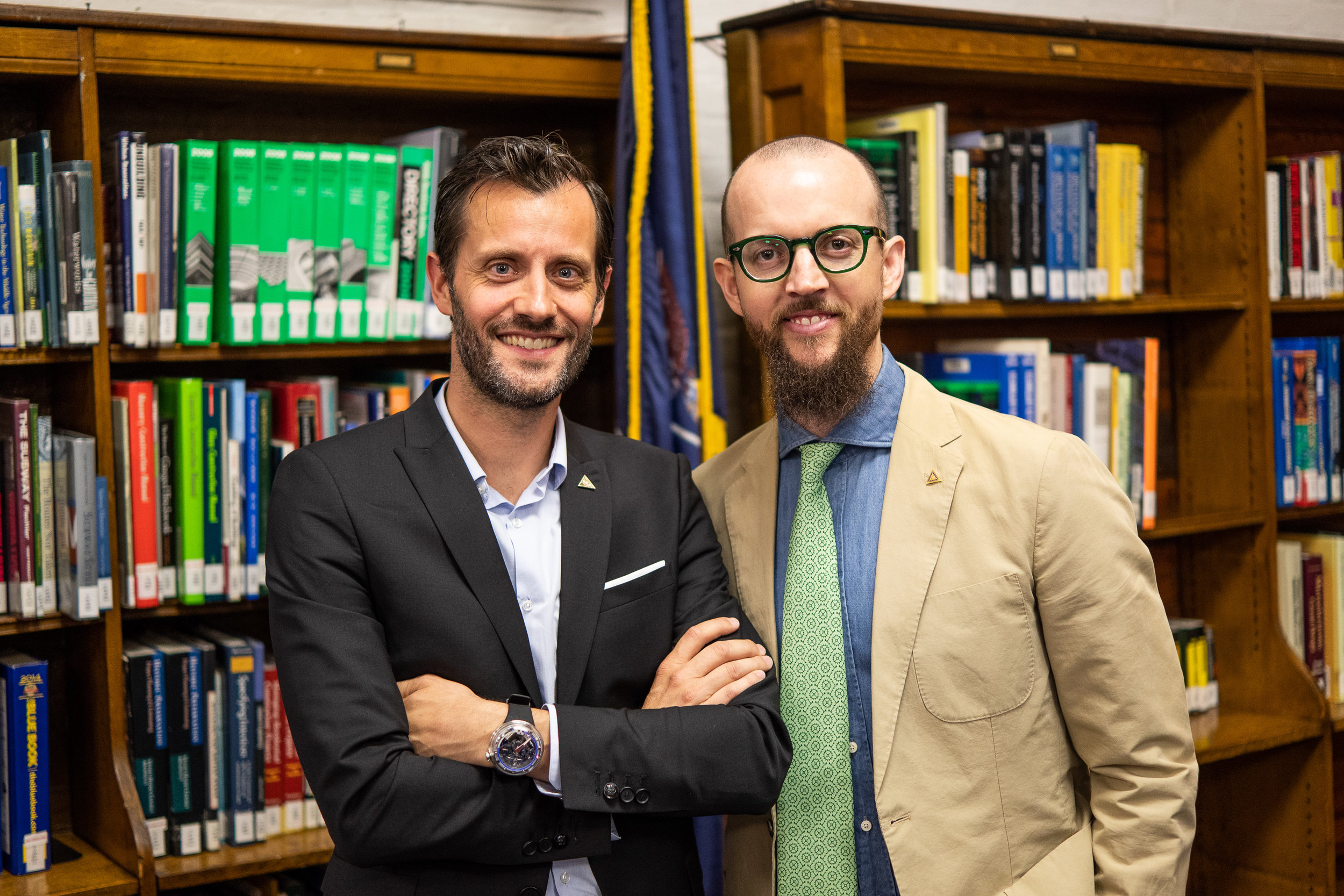


HSNY Welcomes A. Lange & Söhne as a Sponsor
New York City - June 6, 2018
Furthering the Horological Society of New York’s (HSNY) educational mission, German watch manufacture A. Lange & Söhne has joined as a sponsor. A. Lange & Söhne’s generous support will enhance HSNY’s 152-year-old monthly lecture series, horological education classes, watchmaking scholarships, and extensive horological library.
Silvia Juarez-Henry, President of A. Lange & Söhne North America said "We are very glad to support the Horological Society of New York. A. Lange & Söhne takes pride in the craftsmanship and innovation behind our timepieces, and it is important to share that knowledge and make it accessible to the public. The Horological Society of New York is dedicated to advancing the art of watchmaking through education, and we are excited to be part of their mission."
Nicholas Manousos, President of HSNY said "HSNY was founded in 1866 by German immigrants to New York City, with many of our Society's early members having worked or studied in the historical home of German watchmaking, Glashütte. We are delighted to count A. Lange & Söhne, one of the most celebrated German watch brands, as a sponsor. HSNY thanks A. Lange & Söhne for their kind support."
About A. Lange & Söhne
Manufacture A. Lange & Söhne was established in Glashütte, Saxony, by Ferdinand A. Lange in 1845. For the next hundred years, A. Lange & Söhne pocket watches were among the most sought-after timepieces in the world, until the Second World War forced the company into a 40-year hiatus. In 1990, following German reunification, Walter Lange, great-grandson of Ferdinand Adolph Lange, revived the brand and launched the first collection in 1994.
About the Horological Society of New York
Founded in 1866, the Horological Society of New York (HSNY) is one of the oldest continuously operating horological associations in the world. HSNY was started as a guild (union) for working watchmakers in New York. Today, HSNY is a member and sponsor supported 501(c)(3) non-profit focused on education. Its lecture series is a New York tradition, offered monthly for over 150 years. Its award-winning horological education classes travel the world to educate the public on what makes a mechanical watch tick. And its Henry B. Fried Scholarship is awarded annually, benefiting American watchmaking students.
Oklahoma State University School of Watchmaking to Close
Lathe instruction at the OSUIT School of Watchmaking
The School of Watchmaking at the Oklahoma State University Institute of Technology (OSUIT) will close at the end of 2018, after graduation of the current class. A notice was posted to the school’s website: “OSUIT is phasing out the Watchmaking & Microtechnology program within the School of Engineering Technologies. OSUIT will no longer be accepting applications for or enrolling new students in the Watchmaking & Microtechnology program, and only courses required for current students will be offered.”
The OSUIT School of Watchmaking was founded in 1946 and initially focused on education for veterans. As of 2018 the OSUIT School of Watchmaking was one of only a few original programs still in operation at OSUIT. The OSUIT School of Watchmaking was in part funded by the Swiss American Watchmakers Training Alliance (SAWTA). SAWTA is a program created by Rolex to standardize curriculum, testing and certification of watchmaking students in the USA.
The OSUIT Donald W. Reynolds Technology Center
Jerry Tate, a current student at the the OSUIT School of Watchmaking, said, "The OSUIT watchmaking and microtechnology program has produced many accomplished graduates throughout its existence, many of whom are in leadership positions at major watch groups and brands in the US, so it is indeed unfortunate that the program will be closing. My second year classmates and I were concerned when there was not a sufficient number of students to form a new class in January. We looked forward to passing on our lessons learned and helping them through the first year. We are of course very grateful that we were accepted and will be able to complete the program. It should be noted that the closure of four other programs at OSUIT was also announced in addition to the watchmaking program closure."
Jason Champion, the OSUIT School of Watchmaking Program Chair, said, "It is with great regret that after 72 years, Oklahoma State University Institute of Technology will be phasing out the watchmaking program. It saddens me greatly as the program chair, an instructor, and, perhaps most of all, as an alumnus of the institution to see the watchmaking program come to an end. Due to an overwhelming budget crisis in the state of Oklahoma, our campus administration made the difficult decision to close the School of Watchmaking. We are very grateful for the support we have received from SAWTA, and we fully support the training offered to students through this program. We are proud of the level of education we provided to our students and celebrate the success of one of OSU Institute of Technology’s original programs offered since the campus opened in 1946. We appreciate all who have contacted us with their support for our faculty, students and also the institution. We wish our watchmaking students and alumni continued success in the profession that we love so dearly."
With the closure of the OSUIT School of Watchmaking, there are nine full-time watchmaking schools left in the USA.
Member Highlight: Viktor and Pascal Vanelderen
We are always interested in hearing members’ stories about their interest in horology. At our last meeting, a nice gentleman stopped me and asked for his membership lapel pin, having recently joined HSNY. As I was handing him his pin, he asked for one for his son in Belgium. Because his son is a full time student, and membership is free, I gave him a pin for his son, and suggested that his son join our society. A few days later, Pascal Vanelderen surprised me with the wonderful photo above.
Here are their stories:
Pascal Vanelderen
"As I got more discerning about different watches and manufacturers, my interests evolved from the merely aesthetic appearance to gaining insight into the different movements and finally also wanting to be more knowledgeable about the watch industry itself. By roaming the internet during this quest, I ended up discovering the Horological Society of New York and becoming a member. The lectures and meetings are exactly what I am looking for: concise, not shying skepticism and covering all aspects of horology.
After watching numerous lectures on the website, I finally was able to attend a meeting on Monday May 7th (me living in Belgium) which, after a warm welcome from Ed Hydeman and interesting conversations with different members, fulfilled all expectations."
And Viktor’s story
"My love for watches really started off after getting my first higher end watch from my parents for my 16th birthday which was a Breitling Galactic 44. It was really interesting to hear about all the terminology like Swiss escapement, Chronometer vs. Chronograph,... it really fueled my interest because before I could only see and care for the appearance of the watch. My best friends and me discuss what we learn about watches and help raise each others interests. My curiosity is mostly fed by what my dad tells me about watches. We can spend hours talking about everything that is happening in the watchworld. With becoming older I am more and more interested about everything what has to do with watches. I still have much to learn, but I have the time and the curiosity to do so and to explore more about the watchworld and watch community."
Meeting Recap: The Swiss Watch Industry - 20 Years Into the 21st Century
Video recordings of meetings are available to HSNY members.
William Massena, Managing Director of Timezone.com, Trustee of the Horological Society of New York
May 7, 2018
The Swiss watchmaking industry has had its share of ups and downs over the decades, including a period of rapid growth over the last 20 years. At the May 7, 2018, meeting of the Horological Society of New York, William Massena discussed the past, present and future of the Swiss watchmaking industry, posing many thoughtful questions to the audience. The first point Massena addressed was the title of his lecture, "The Swiss Watch Industry: 20 Years Into the 21st Century." Massena explained that even though we are only in the year 2018, the 21st century really started for the Swiss watchmaking industry in 1998 when the Asian financial crisis caused a large portion of the Swiss watchmaking industry to bring their distribution channels in-house.
Massena then discussed the large conglomerates operating in the Swiss watchmaking industry today, explaining their successes and failures. Panerai was used as an example of a brand that is having difficulty today. Their strategy of abundant limited editions of similar watches painted the brand into a corner, where customers stopped being interested. Massena explained that this scenario has played out many times, and made the case that large watch brands today are essentially marketing machines first. Massena also showed how brands in the same group will market very similar watches at different price points, with only minor differences in quality.
Independent watch brands were then discussed, with Rolex being the first example. Rolex does offer similar watches at different price points, but Massena showed how this is largely tied to the amount of precious materials used in the watch. Audemars Piguet and Patek Philippe were also cited as examples of successful independent watch brands. Massena explained that the smaller independent watch brands, such as Richard Mille and MB&F are also doing quite well today, in contrast to the challenges faced by the brands owned by large conglomerates. Massena concluded by discussing the future. He stated that larger independent brands will continue do well, and that new watch buyers are looking for innovation, rather than the traditional watches that their grandfathers wore.
HSNY thanks William Massena for his fascinating lecture!
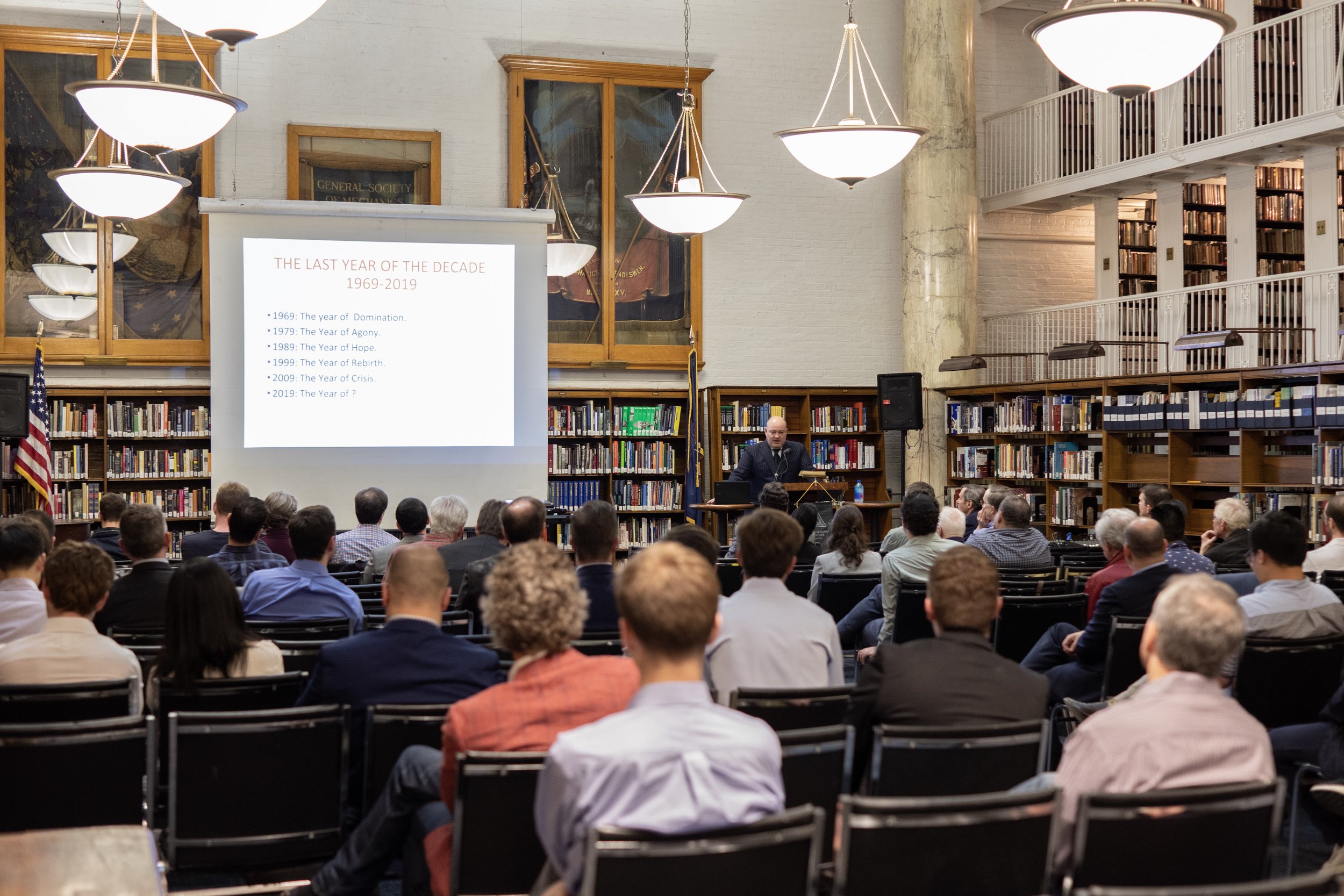



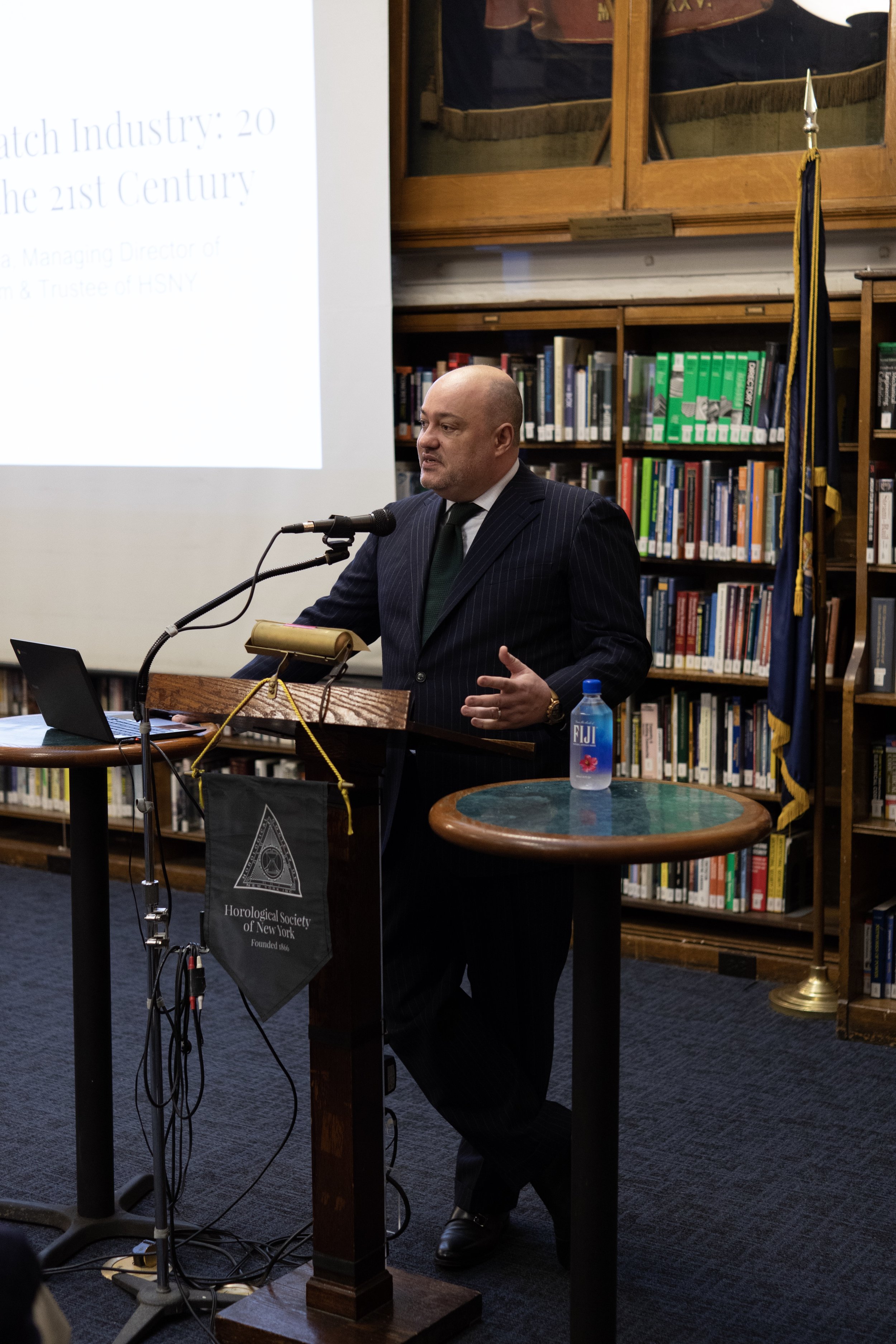




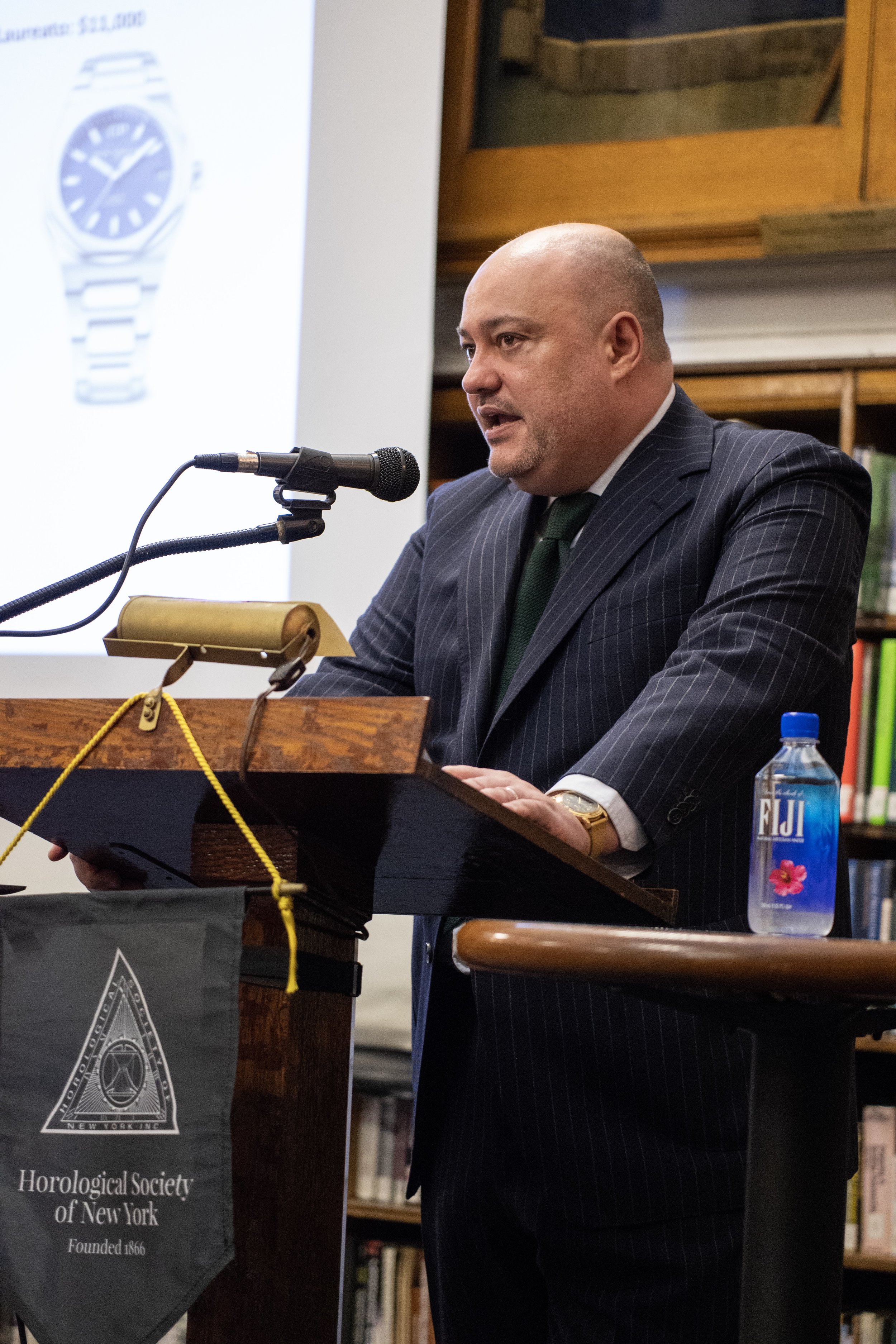




Event Recap: HSNY 2018 Gala & Charity Auction
Video recordings of meetings are available to HSNY members.
On April 18, 2018, the Horological Society of New York celebrated its 152nd anniversary with a gala dinner and charity auction in Midtown Manhattan. Members and guests from across the country gathered to celebrate New York's horological tradition, see the presentation of the Henry B. Fried Scholarship, and bid on a collection of extraordinary timepieces and horological miscellanea.
Nicholas Manousos (HSNY's President, left) and Steve Eagle (HSNY's Director of Education, right) presenting the 2018 Henry B. Fried Scholarship to Mark Duckett (middle left) and Erik Gonzalez (middle right).
The Henry B. Fried Scholarship was established to assist American watchmaking students in their studies at full-time watchmaking schools. Two scholarships for $10,000 each were awarded at the 2018 Gala by HSNY's Director of Education, Steve Eagle. The 2018 awardees are Mark Duckett and Erik Gonzalez, students at the Patek Philippe Institute in New York.
John Reardon, International Head of Watches for Christie's, calling the HSNY 2018 Charity Auction
A collection of extraordinary timepieces and horological miscellanea was auctioned at the 2018 Gala, with proceeds going towards HSNY's ongoing educational programs. The charity auction was hosted by Christie's International Head of Watches, John Reardon.
The crowd was a diverse mix of watchmakers, clockmakers, collectors, journalists, auctioneers and executives, reflecting the friendship and generosity of the horological industry. Plans for HSNY's 2019 Gala are already underway, we are looking forward to seeing you there!



